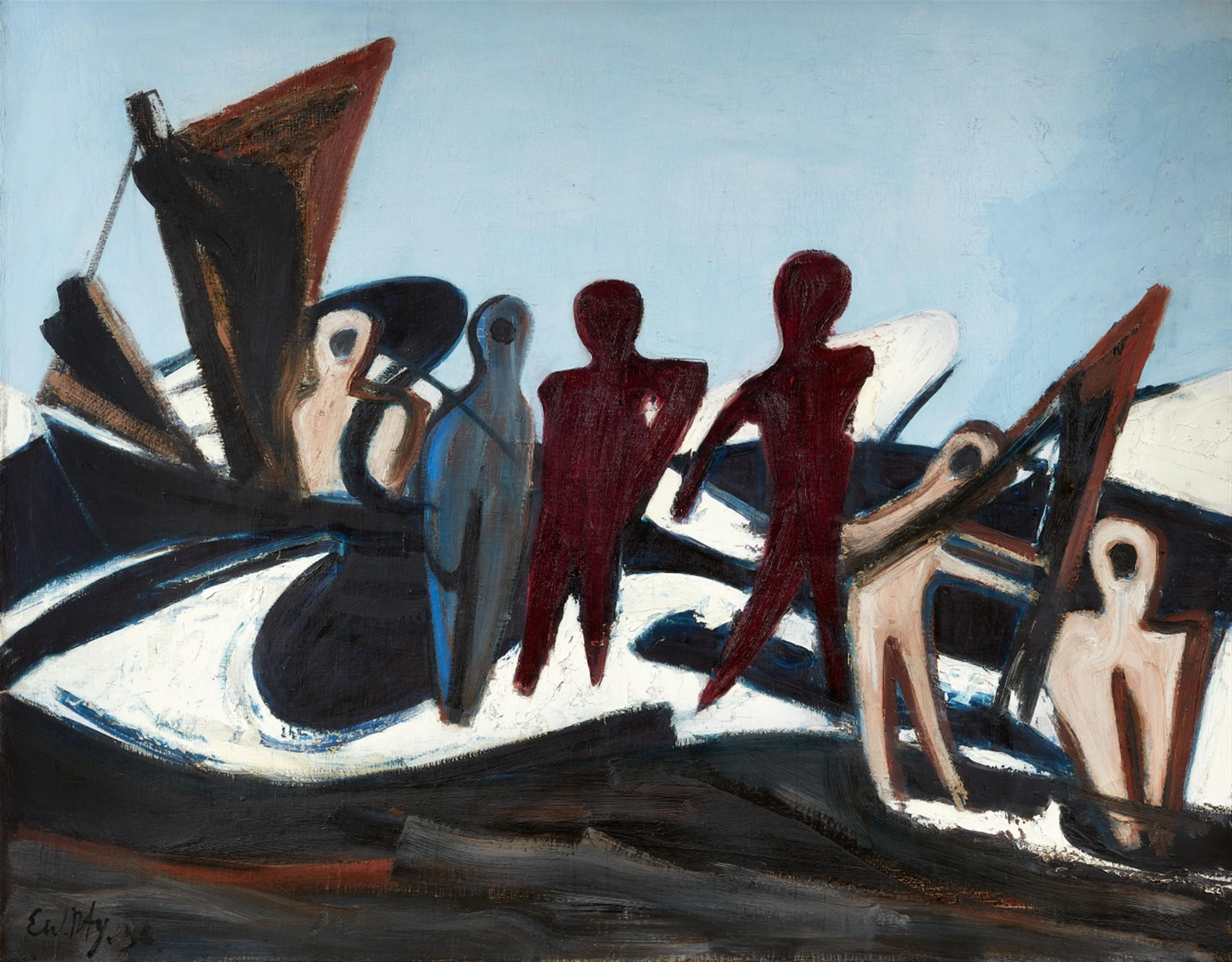Ernst Wilhelm Nay
Fischer
1936
Oil on canvas 106 x 136 cm Framed. Signed 'E. W. Nay. 36' in black lower left and signed, dated and titled '1936'. - In fine condition. Partially with fine craqueleur.
From 1935, after a brief Surrealist phase, Ernst Wilhelm Nay began to become intensely occupied with the subject of figure, sea and landscape, which he - to put it mildly - processed in a serial manner: subjects like "Dünenlandschaften" (Dune Landscapes), "Wellen" (Waves), "Nächtliches Meer" (Nocturnal Sea), "Segelboote nachts auf dem Meer" (Sailing Boats on the Sea at Night) and "Stürmische Wellen" (Stormy Waves) were also followed by a series of pictures dealing with themes like "Ausfahrt der Fischer" (Departure of the Fishermen), "Ostseefischer" (Baltic Fishermen) and "Fischer mit Netzen" (Fishermen with Nets) or this painting, entitled “Fischer”, which was painted in 1936. Nay drew sculpture-like symbols of bodies, signified fishing boats by means of masts and sails and massively dynamised the compositions with large passages of white, foaming breakers before a blue sky. In the power of nature, the fishermen sway like marionettes; Nay created abstract versions of scenes from the rugged daily life along the Baltic Sea. The everyday event dissolves in the power of contrasting colours and the abstract formal idiom. Nay experienced the work of the fishermen in its simple primitiveness and vitality in the little community of Wicko Morskie (then: Vietzkerstrand) in the Pomeranian district of Slawno. Nay had already spent the summer of 1935 there, and it stimulated him in an extraordinarily productive manner. Thus in a letter from 7 February 1937, sent to Frankfurt am Main to the collector Carl Hagemann, who had just purchased a painting of fishermen, Nay relates: “the fundamental aspect of my art, precisely that which constitutes its novelty […] is simultaneously my core, the law of my life, is now also the primal law of all life in general: that mythical bond which I spoke about for the first time what is now 7 years ago. This is to be understood as humanity's primeval bond with the earth and sky; earth and sky are forms of the eternal motion, becoming and declining, eternity. However often I've contemplated this, it will nonetheless forever remain impossible for me to express myself more clearly, because this is - after all - not a programme, not a theory or a religious notion, more a vision.” (Letter from Ernst Wilhelm Nay to Carl Hagemann from 7 Feb. 1937, in: Kirchner, Schmidt-Rottluff, Nolde, Nay ... Briefe an den Sammler und Mäzen Carl Hagemann. Edited by Hans Delfs, Mario-Andreas von Lüttichau and Roland Scotti, Hatje Cantz Verlag, Ostfildern-Ruit, 2004, no. 796).
Through his occupation with structured two-dimensional networks and a constantly increasing concentration of figurative pictorial structures, the artist developed his first complex pictorial subject matter. Underlaid with rhythm and dynamism, in clearly organised structures that simplify the objective world and sometimes even become abstract, the paintings of fishermen preserve a figurative remnant within their grandly conceived compositions of formal and chromatic abundance. Nay's precise notion of and approach to formal clarification revealed paths of stylistic transformation to him on his way to abstraction.
Catalogue Raisonné
Scheibler 198
Provenance
Uli Nimptsch, London; Galerie Dieter Brusberg, Berlin (2011); Private collection, North Germany

